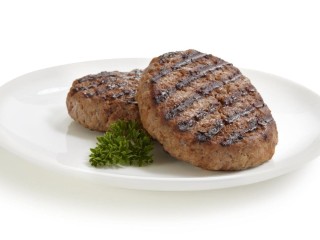 It’s a sad reflection of modern life that across Australia, there’s a growing portion of the population that needs a hand in regularly putting food on the table for family members.
It’s a sad reflection of modern life that across Australia, there’s a growing portion of the population that needs a hand in regularly putting food on the table for family members.
In southern Queensland alone, the Foodbank charity group is responsible for generating sufficient food ingredients to provide 75,000 meals each week.
That assistance might come in the form of putting breakfast in front of a young student whose home-life might mean they otherwise would go to school hungry, through to providing meals in refuges for battered wives, or simply helping-out those who are on the margins of society, for various reasons.
Foodbank Australia is a national organisation established 15 years ago, dedicated to gathering and distributing donated foodstuffs among charities that help the needy. It does not cook or prepare meals itself, but acts as a food collection and distribution ‘hub’ sourcing and supplying raw ingredients to no less than 300 registered charities.
None of the food collected is past its use-by date or compromised in some other way, and anybody would be happy to consume it.
To this point, Foodbank’s focus has been on providing staples including bread, breakfast cereal and noodles as carb sources; milk; fruit and vegetables and dry grocery lines.
In the case of bread, Foodbank has established highly successful supply chains, linking donated farmers’ grain with millers who process it into flour, to bakers who bake it. Supermarket chains including Woolworths and Coles regularly supply large volumes of non-perishable grocery lines.
Some of the Foodbank group’s turnover figures are truly astonishing. Nationally, large manufacturers donate two million litres of milk each year. All of the major fruit and veg markets across the country regularly contribute surplus product into the network. Similarly, smallcrop farmers in areas like the Lockyer Valley frequently make donations of surplus product.
In Queensland alone, Foodbank last year put nine million kilograms of food through its Murarrie warehouse and cold storage facility.
Beef seen as new frontier
 Now the group’s focus is expanding to include sources of meat protein. That’s where beef comes in.
Now the group’s focus is expanding to include sources of meat protein. That’s where beef comes in.
“The major food group category that’s missing from the current list is meat protein,” said David Crombie, former National Farmers Federation president and a member of the Foodbank Queensland board.
In the first phase of building supply support, Foodbank has started discussions with a number of meat groups.
One of the first to engage was JBS Australia, which under a trial has supplied around one tonne of patties per week for the past two months through its Food Partners value-adding plant near Ipswich. That’s enough to provide a weekly red meat meal for 7000 people.
In parallel, a small emerging sub-project called ‘Beefbank’ is underway, coordinated through the Rotary service organisation, where producers can donate one or two animals for processing through participating regional meatworks.
Mr Crombie said patties were ideal for the charity’s application, being easy to cook, easy to serve, containing good protein, and versatile enough to be utilised easily in other dishes like bolognaise or lasagne.
He said this year’s flood events in Queensland had put an extra level of demand into Foodbank’s operations in Queensland.
“That occurred not only when the floods were happening, but even now. We’re getting huge demand from people right now who for various reasons, just can’t bloody make it,” he said.
Mr Crombie said while it was still in its formative stages, Foodbank wanted to establish effective supply chain partnerships for beef, along the lines of what already occurred in bread supply.
“Smaller beef producers might like to donate a beast here or there. Larger-scale one might consider donating a deck. Processors would donate the kill, and that minced product would be turned into patties. Transport and packaging companies are already lending their support, and Foodbank would assemble the product and distribute it among the charities,” Mr Crombie said.
While Foodbank could act as a facilitator, it did not have the resources to manage each and every supply chain, being manned almost entirely by volunteer labour. This meant the opportunity was there for industry stakeholders to “step-in, pick it up and run with it.”
While Foodbank did not yet have the entire package in place to start accepting livestock or beef patties as part of the expanded supply program, it was keen to start spreading awareness about the opportunity, and building support and capacity through various supply chains when it was ready.
“We’re not there yet, but we are putting the platform in place. Realistically it could still be a few months away, but we’ll be aiming to make it happen as soon as possible,” Mr Crombie said.
Queensland would act as the pilot for the red meat project, but other states would inevitably follow once the process was bedded-down.
Mr Crombie has strong views about the role the farm sector can play in helping groups like Foodbank meet its objectives.
“In agriculture, we tend to talk a lot about the things we do and the achievements we make, and a lot of that is to do with the sale of our products. But there is also a lot of merit in looking at establishing a stronger community link, in farmers donating product free back into the community for those who cannot afford it. It can serve to build those relationships between city and country that are so badly needed,” he said.
“Farmers are not just seeking support themselves during times of drought or flood, but are putting back the other way, where they can. Six months ago, we were pushing food parcels into the Lockyer Valley after the region’s devastating floods. Now, we are receiving produce in great quantity out of exactly the same area. What goes around, comes around.”
-
Beef Central will keep readers advised when the supply process is in place to allow the contribution of livestock to start, and who to contact. As an industry, let’s get behind this great cause. To see more about Foodbank’s work, click here.
